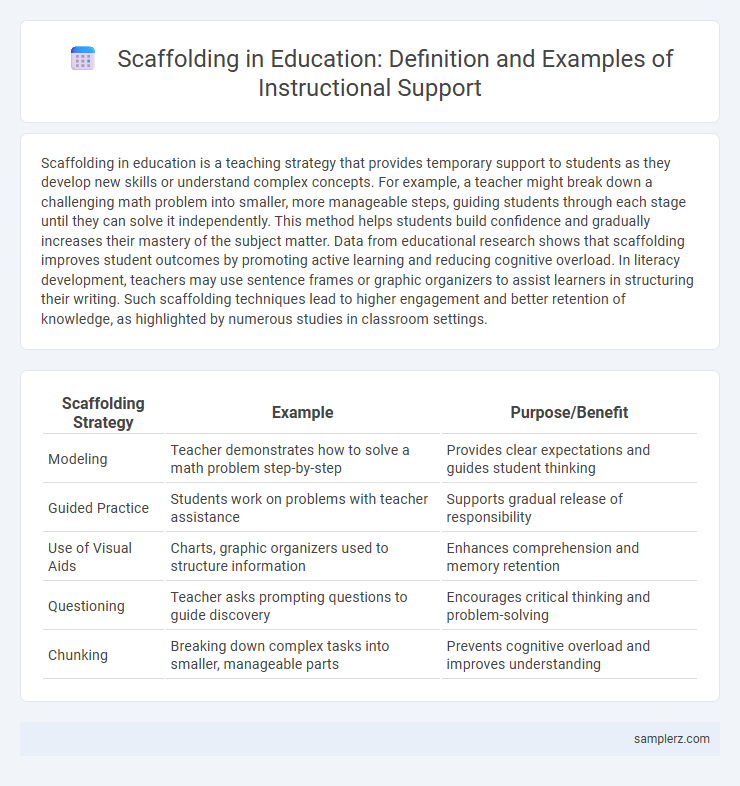Scaffolding in education is a teaching strategy that provides temporary support to students as they develop new skills or understand complex concepts. For example, a teacher might break down a challenging math problem into smaller, more manageable steps, guiding students through each stage until they can solve it independently. This method helps students build confidence and gradually increases their mastery of the subject matter. Data from educational research shows that scaffolding improves student outcomes by promoting active learning and reducing cognitive overload. In literacy development, teachers may use sentence frames or graphic organizers to assist learners in structuring their writing. Such scaffolding techniques lead to higher engagement and better retention of knowledge, as highlighted by numerous studies in classroom settings.
Table of Comparison
| Scaffolding Strategy | Example | Purpose/Benefit |
|---|---|---|
| Modeling | Teacher demonstrates how to solve a math problem step-by-step | Provides clear expectations and guides student thinking |
| Guided Practice | Students work on problems with teacher assistance | Supports gradual release of responsibility |
| Use of Visual Aids | Charts, graphic organizers used to structure information | Enhances comprehension and memory retention |
| Questioning | Teacher asks prompting questions to guide discovery | Encourages critical thinking and problem-solving |
| Chunking | Breaking down complex tasks into smaller, manageable parts | Prevents cognitive overload and improves understanding |
Introduction to Scaffolding in Educational Support
Scaffolding in educational support involves providing temporary structures tailored to students' current abilities, such as guided questioning and modeling problem-solving steps, to enhance learning and comprehension. Teachers gradually reduce assistance as learners gain independence, promoting deeper understanding and skill mastery. Effective scaffolding adapts to individual needs, fostering confidence and academic growth within diverse learning environments.
Collaborative Group Work as Scaffolding
Collaborative group work serves as effective scaffolding by enabling students to share diverse perspectives and build on each other's knowledge, enhancing comprehension and problem-solving skills. This instructional strategy promotes peer-assisted learning, where more knowledgeable group members guide others through complex tasks, gradually increasing individual autonomy. Research shows that structured group interactions boost engagement and academic achievement, especially in subjects requiring critical thinking and application.
Modeling and Demonstration Techniques
Modeling and demonstration techniques in scaffolding involve teachers actively showing students how to approach a task or solve a problem, providing clear examples of the desired process or outcome. This hands-on approach helps learners internalize strategies by observing expert performance before attempting tasks independently. Effective use of these techniques enhances comprehension and skill acquisition in complex subjects such as mathematics and science.
Graphic Organizers for Concept Clarity
Graphic organizers serve as effective scaffolding tools by visually structuring information to enhance students' concept clarity and comprehension. These tools help learners break down complex ideas into manageable parts, supporting cognitive processing and retention. Examples include Venn diagrams for comparing concepts, flowcharts for sequencing events, and mind maps for illustrating relationships among key ideas.
Guided Practice and Feedback
Guided practice in education involves actively engaging students with structured tasks that reinforce new concepts, allowing them to apply knowledge under teacher supervision. Immediate, specific feedback during this phase helps learners identify errors and refine their understanding, enhancing skill acquisition. This scaffolding technique fosters independent problem-solving by gradually reducing support as proficiency increases.
Questioning Strategies to Foster Understanding
Effective questioning strategies in education include using open-ended questions that encourage critical thinking and deeper comprehension. Teachers scaffold learning by prompting students to explain reasoning, predict outcomes, and connect new information to prior knowledge. This guided questioning helps students build conceptual understanding and gain confidence in applying their knowledge.
Scaffolding Through Think-Alouds
Scaffolding through think-alouds involves educators verbalizing their thought processes while solving a problem or completing a task to model cognitive strategies for students. This technique helps students develop metacognitive skills and understand complex concepts by making invisible thinking visible. Research indicates that think-alouds improve comprehension and problem-solving abilities, especially in subjects like reading and mathematics.
Sentence Starters and Writing Frames
Sentence starters and writing frames provide structured support that guides students through the writing process by offering clear prompts and organizational patterns. These scaffolding tools help learners develop ideas, maintain coherence, and build confidence in constructing sentences and paragraphs. Research shows that such strategies enhance language acquisition and improve overall writing skills, particularly for English language learners and students with learning disabilities.
Using Technology for Scaffolding Learning
Using technology for scaffolding learning can involve interactive software that adapts to student responses, providing immediate feedback and tailored hints to guide problem-solving. Digital platforms like virtual simulations and educational apps break complex tasks into manageable steps, enabling learners to build skills progressively. Incorporating tools such as online discussion forums and video tutorials fosters collaborative support and reinforces understanding through multimedia resources.
Gradual Release of Responsibility in Scaffolding
Gradual Release of Responsibility (GRR) in scaffolding supports student learning by shifting the cognitive load from teacher to student through phases: "I do," "We do," and "You do." This method begins with explicit teacher modeling, followed by guided practice with shared responsibility, and culminates in independent student application. GRR fosters student autonomy and deeper comprehension by progressively building skills and confidence in educational settings.

example of scaffolding in support Infographic
 samplerz.com
samplerz.com